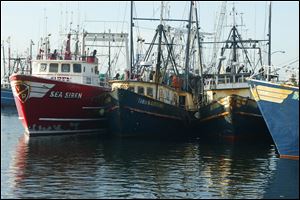
U.S. seafood catch reaches 17-year high
All regions show increases in catch numbers
9/19/2012
New Bedford, Mass., had the highest-valued catch for the 12th straight year, due largely to its scallop fishery.
PORTLAND, Maine — The U.S. seafood catch reached a 17-year high last year, with all fishing regions of the country showing increases in both the volume and value of their harvests.
Commercial fishermen last year caught 10.1 billion pounds of fish and shellfish valued at a record $5.3 billion, according to a report released Wednesday by the National Oceanic and Atmospheric Administration. That's a 23 percent increase in catch by weight and a 17 percent increase in value over 2010.
New Bedford, Mass., was the highest-valued port for the 12th straight year, due largely to its scallop fishery. Dutch Harbor, Alaska, was the No. 1 port for seafood volume for the 15th year in a row.
The increases are evidence that fish populations are rebuilding, said Sam Rauch, deputy assistant administrator for NOAA's Fisheries Service.
Still, a number of fisheries are in trouble. The Department of Commerce has declared disasters for cod and other so-called groundfish in New England, oyster and blue crab fisheries in Mississippi, and chinook salmon in Alaska's Yukon and Kuskokwin rivers.
"Overall nationally, the numbers are very good news," Rauch said. "But we don't want to miss the fact that there are parts of the industry that are or soon will be suffering economic pain."
Alaska led all states by far in catch volume, with 5.4 billion pounds, followed by Louisiana, California, Virginia and Washington, according to the report. Alaska was also tops in the value of its catch, at $1.9 billion, followed by Massachusetts, Maine, Louisiana and Washington.
Fishermen brought 706 million pounds of product to Dutch Harbor, the leading port by volume, while New Bedford, the top port by value, had $369 million worth of seafood cross its docks.
All nine of NOAA's fishing regions saw the volume and value of their catches go up in 2011. The numbers nationally were boosted by sharp increases for Gulf of Mexico menhaden, Alaska pollock and Pacific hake, also known as whiting.
The catch in the Gulf of Mexico rose to its highest volume since 1999 following a 2010 fishing season that was shortened by the Deepwater Horizon oil spill. In all, last year's Gulf catch rose 55 percent to nearly 2 billion pounds, with the value rising 25 percent to $797 million.
While certain regions were bolstered by strong showings in some fisheries, other sectors didn't fare so well.
New England, for instance, had strong lobster and scallop harvests. At the same time, fishermen who catch groundfish were having a tough time of it, with sharp cuts in quotas expected for next year because of dwindling populations.
It's good that the overall harvest numbers are growing nationwide, but that doesn't help groundfishermen, said Russell Shearman, 64, who fishes out of Gloucester, Mass.
Sherman, who owns a 72-foot boat, has had to spend $40,000 of his personal savings the past two years to keep his business afloat. With groundfishing in such bad shape, he's trying his hand at catching squid for the first time, he said.
"I'm pretty much out of business in groundfishing," he said in a phone interview from Stonington, Conn., where he was preparing to go squid fishing. "I'm nearing retirement, only I'm not retiring because I can't afford to."
Rauch said he expects the overall catch to continue going up in the years ahead, thanks to rebuilding fish populations and improved fisheries management.
The report also showed that Americans ate an average of 15 pounds of seafood per person in 2011, down from 15.8 pounds in 2010.
About 91 percent of the seafood consumed in the U.S. was imported, up from 86 percent in 2010. A portion of the imported seafood, however, was caught by U.S. fishermen, exported to other countries for processing then imported back into the U.S.